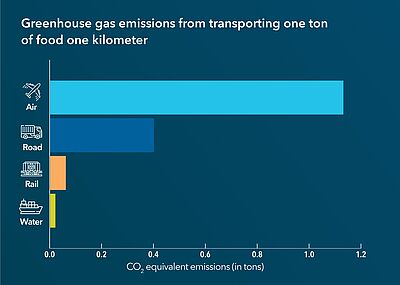Sustainability has become more than just a buzzword – it’s now an essential consideration across industries, for stakeholders across the supply chain. Environmental, social and corporate governance (ESG) strategies and new legislation encourage greener and more ethical supply chains – for instance, by mandating reports about and plans to address carbon emissions or labor conditions. At the same time, both environmental and ethical impact play an important role in consumers’ purchasing decisions.
Customer expectations for sustainability are especially high in grocery retail, where the majority of consumers aim to minimize the environmental impact of their purchasing behavior.1 In one global study from 2023, 71% of consumers considered it very important2 that grocery brands commit to sustainability initiatives. And with supply chain responsible for around 90% of greenhouse gas (GHG) emissions for consumer packaged goods businesses, there is significant pressure on end-to-end supply chains to reduce their carbon footprint.3
Let’s talk sustainable supply chain solutions
From sustainable transportation networks to alternative sourcing to supplier mapping or auditing, our supply chain sustainability experts work with you to find your optimal solution.
Transportation – a small share of total emissions but a significant lever in retailers’ power
It is widely believed that processing and logistics steps like storage, packaging and especially transportation cause most emissions in the supply chain. For most food, these steps are responsible for less than 10% of products’ greenhouse gas emissions – and with some products, such as beef, this proportion is less than 1%.4 By far the bigger factors are related to production: farming, land use and, in the case of animal products, feed for livestock.
One reason for the comparatively low share of transportation in total product GHG emissions is that very few food products are shipped by air freight – which creates 50 times more CO2-equivalent emissions per ton kilometer than sea freight. As investigated in a global food transportation study, air-freighted food makes up only 0.16% of total food miles. Rail transportation accounts for about 10% of food miles globally; road, about 30%; and water the remaining 60%.5
As retail businesses generally have only a small influence on upstream processes in production and logistics, transportation can be an important sustainability lever within their scope of influence. Establishing transparency and creating an emissions baseline is the first step. From here, reduction measures can be identified, such as switching to intermodal transportation and using alternative drives for road freight, for instance with electric or hydrogen trucks.
As another measure, network optimization helps businesses improve transportation efficiency and reduce shipping distances, for example by finding optimal warehouse locations. A more centralized network with fewer locations can be greatly economically beneficial from a transportation and warehousing perspective. Businesses can decide whether to perform emission tracking and network optimization in-house with software support, or with the help of external partners.
Why local sourcing isn’t always more sustainable than global
Sourcing plays a large role in supply chain sustainability, and even more so in grocery, where production and storage often depend on certain environmental conditions.
Many grocery products require special climate conditions, such as citrus fruits, which require lots of warmth and light. Growing them in colder, darker regions requires high amounts of energy for heating and lighting, which greatly increases their environmental impact. For most parts of the US, it is more environmentally sustainable to ship products like citrus fruits, grapes, nuts and berries across the country from Florida or California or import them from other parts of the world than grow them locally.
Even if fruits and vegetables do grow well locally, they are often seasonal products – and ensuring fresh stock in stores year-round increases their carbon footprint significantly. For example, because of the emissions involved in cold storage, apples shipped from South America to England by sea have half the carbon footprint of UK-grown apples kept in storage for 10 months.6
Cooling for groceries can account for more than 60% of warehouses’ electricity consumption.7 An easily implementable switch from regular electricity to renewable energy can have significant impact. In a warehouse space of 50,000m² (around 540,000 ft2), this switch can save approximately as much CO2 per year as 1000 trucks emit by driving 200 km, or about 125 miles.8 Network optimization can also help reduce emissions by identifying unnecessary warehouses.
Given the sustainability impact of production and storage, businesses need to look within their value networks to ensure suppliers are aligned with their corporate sustainability strategy. Businesses can consider integrating sustainability guidelines into tendering documents, for instance. Measures could include requiring suppliers to commit to ethical sourcing of raw materials or looking for logistics service providers that have earned certifications for their sustainable practices.
Beyond CO2 – the role of social sustainability in supply chains
Social responsibility is becoming a legal requirement for supply chains. Legislation like the German Supply Chain Due Diligence Act mandates that businesses identify, rectify and prevent human rights violations in their value chains. The proposed EU Corporate Sustainability Due Diligence Directive would extend this requirement internationally to businesses with at least 500 employees and €150 million annual global turnover and smaller businesses in high-impact sectors like textiles, agriculture or mining – in total, nearly 13,000 businesses across Europe and some additional 4,000 non-EU-based organizations with revenue in the EU.9
In addition, the social-ethical impact of products is important to customers – in Europe, fair pay across the supply chain and lack of child labor are among the five most significant motivators for customers to pay more for a product.10
Even if the environmental impact of transporting products from overseas is not a reason to look for alternative sources, working conditions in large producing countries are often inadequate and beyond retailers’ scopes of action. Because there is no standard global system of values regarding human rights, collaborating with supply chain partners is essential to ensure fair labor conditions.
As one approach, supply chain mapping creates transparency over supply networks and helps businesses find opportunities to optimize transportation and reduce emissions. Supply chain mapping involves using public, private and shared data about suppliers, including information about regional, geopolitical or industry developments, to identify risks – especially those related to social and environmental sustainability.
Establishing clear guidelines, fostering trust, and incentivizing data sharing are keys to successful implementation.
Taking the first step towards a sustainable sourcing strategy
Transportation, suppliers and social responsibility are three key elements within retailers’ scope of action to consider when developing a sustainable sourcing strategy. Collaboration with partners and suppliers is essential to ensure transparency and align on values. By prioritizing sustainability across their value chains, retailers can meet stakeholder expectations, comply with new legal requirements and encourage the development of a more sustainable global economy through multiplier effects.
Looking for more information on sustainability in retail supply chains?
Learn about developments in sustainability, digitization and more – and their effects on retail supply chains – in the 4flow pre-study on retail trends.
Authors

Eric Breitbarth
Senior Expert
4flow research

Jan Oppermann
Principal and Head of Sustainability Practice
4flow consulting

Hanka Smiejczak
Vice President
4flow consulting
Sources
1 - Capgemini: Sustainability ranks high on consumers’ shopping list (supermarketnews.com); Majority of Shoppers Say Retailers Could Do More To Be Sustainable (winsightgrocerybusiness.com); 20-06_9880_Sustainability-in-CPR_Final_Web-1.pdf (capgemini.com)
2 - Amazon Ads: Sustainability and DEI in the grocery industry
3 - Zurich Insurance: How to reduce carbon in our supply chains – and why it matters
4 - Our World in Data: You want to reduce the carbon footprint of your food? Focus on what you eat, not whether your food is local
5 - Our World in Data: You want to reduce the carbon footprint of your food? Focus on what you eat, not whether your food is local
6 - Chathamhouse: 2019-10-14-HoffmanCentreTradeandFoodSystems.pdf (chathamhouse.org)
7 - Energy Build: J.A. Evans. Specific energy consumption values for various refrigerated food cold stores. (2014).
8 - CBECS: A calculation for Germany where green electricity saves around 90% CO2e emissions. See comparable data at: Energy Information Administration (EIA)- Commercial Buildings Energy Consumption Survey
9- Europa: Corporate sustainability due diligence (europa.eu)
10 - McKinsey: The path forward for sustainability in European grocery retail

